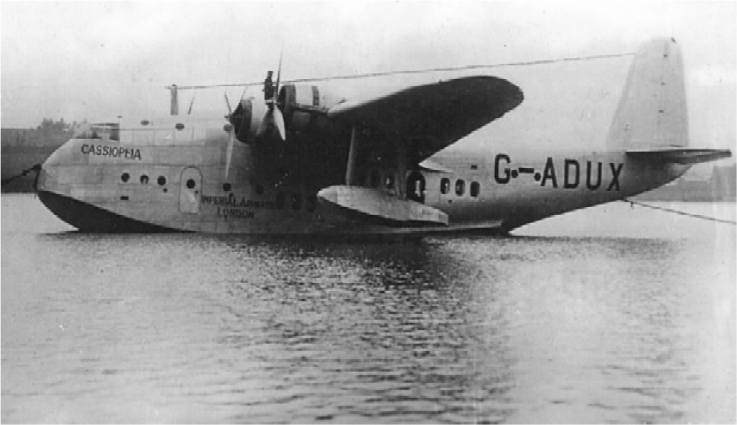- Home
- Show Content
FLYING BOAT- CASSIOPEIA IN THE ISLANDS SKY

FLYING BOAT- CASSIOPEIA IN THE ISLANDS SKY
It was much wonderment to the residents of Port Blair when a flying boat named 'Cassiopeia' made its first landing at Port Blair harbour on 22"' December 1941 from Calcutta (now Kolkata) via Akyab (upper Burma) and Rangoon. The flying boat looked like a giant seagull stretching its wings rode on the calm waters of Port Blair Harbour skimming, leaving a trail of white foam and noise.
The flying boat Cassiopeia taxied up to a moored motor launch in the harbour where some people alighted with the mails brought in and some boarded the flying boat for onward journey. After refuelling, the flying boat 'Cassiopeia' G-ADUX commanded by Capt. C.E. Madge started her engines, the sound boomed across the water and Cassiopeia lifted her nose, climbed steeply in the sky. Lumbering along at a speed of 160 miles per hour, she headed towards Seletar (north eastern part of Singapore) via Sabang and Medan (Sumatra). From Singapore further service was connected through flying boats operated by Qantas Empire Airways (Australia).
The Cassiopeia was one of the empire 'C'- class flying boat which were developed for the purpose of the British Govt's Empire Air Mail services from England to Australia and Africa for their Colonial administration. British Govt., who in 1933 had requested aviation manufacturer Short Brothers to design some big new long-range monoplanes which could alight and take off from any reasonably large body of calm water, so were capable of making frequent stops that flying long distance required. Accordingly, some 42 such flying boats were manufactured during 1936-40. All these aircrafts received names starting with the letter 'C'. They were operated jointly by BOAC(British) and Qantas Empire Airways(Australia).The flying boats made it possible to have regular air transport between the areas where there were no airfields for land-based aircraft, and could stop at small island, river, lake or coastal stations to refuel and resupply. The flying boats contained a galley, wine cellar, plenty of space to stroll about and a promenade deck with its high handrail and windows at eye level to gaze at the world of cloud and sky outside the landscape and Ocean below passed serenely by. Cabins could also be converted into sleeping accommodation at night, in much the same way as in a rail journey. The first ever in- flight service was also available in the flying boats, served by smartly dressed stewards. The flying boats did not operate during the night, so the voyage from England to Australia required nine overnight stops. Passenger stayed at luxury hotels or in accommodation built specially by the airlines. At the time many major cities around the world already possessed water airports, or marine air terminals as they were called in the United States. The flying boats reduced the time taken to travel to Australia from England by air to an unbelievable nine days, significantly faster than a sea journey besides the passengers experiencing a leisurely taste of exotic lands from the comfortable Flying Boats. This was considered aviation's golden age, a time when modernity and luxury combined to define an era in WorldTravel. There were 30 stops between Sydney and London. Travelers in the flying boats experienced as if they are 'sailing in the skies'. Indeed, Short Brothers, the company who built these flying boats claimed- "we don't build aircraft, that float, we build ships that fly". The journey used to start from Southampton (England) via Marseilles (France), Brindisi (Italy), Athens (Greece), Alexandria (Egypt), Karachi (Pakistan)then by land-based aircraft via Jodhpur, Delhi to Calcutta. From Calcutta, the flying boat turned to south across the Bay of Bengal to Akyab (Upper Burma), Rangoon (lower Burma) to Port Blair(Andamans)/Bangkok in Thailand and to Singapore. From Singapore, the crews of Qantas Empire Airways (Australian Airline Company), carried the aircrafts onwards through the East Indies to Darwin in Australia, and around the north of that country to complete the journey at Sydney Harbour. But it was all short lived. With the onset of World War II. For although during the first three years of the war, from1939-1942, the 'Empire' route to London via Singapore remained in operation. In the mean while vulnerability of the vital air route to Japanese aggression was realized, and plans made to gain against it.
Three reserve routes were planned between Calcutta and Darwin(Australia). If the situation worsened, the coast of lower Burma could be avoided by flying from Rangoon to Port Blair or Nancowry in the Andaman Islands in the Bay of Bengal, then via Sabang and Penang to Singapore. If Malaya is captured by the Japanese, it was intended to divert the flying boat from Port Blair and Sabang to Padang in Sumatra, Batavia in Java, and so on to Australia. These were the three phases of what was known as the "Far East Reserve routes" in the event of Japanese aggression.
Since the war was looming in the area with Japanese advancement, the flying boat services disrupted with the fall of Singapore on 15" march1942 and thereafter Port Blair was also captured by Japanese force on 23rd march1942. The last flying boat to touch Port Blair were on 9th and 10th Feb.1942.Flying boat commanded by Capt. Gurney made its water landing at Port Blair harbour on 9th Feb.'42 and at dawn on10th Feb.'42 it departed for Singapore when another flying boat 'Clifton' commanded by Capt. Tapp reached Port Blair from Calcutta via Akyab (upper Burma) and Rangoon (lower Burma). Clifton was refuelled and tried to take off, but had engine power problem. After carrying out minor repair, left Port Blair on 11th Feb. for Sibolga(Sumatra), remained overnight at Sibolga and left for Batavia(Java) from where it reached Broome (west coast of Australia). Though a number of Flying boats were destroyed during 2nd World War which disrupted the long air connectivity from England to Australia. But their services were later utilized by holiday makers at Southampton (England) for flying to Isles of Scilly and Falmouth. Similarly, at Rose Bay (Australia), flying boats were quite popular amongst the holiday makers to visit Fiji Islands and New Caledonia. However, the growing popularity of advanced aircrafts and rising costs on maintaining aging flying boats, eventually forced the ending of Golden Era of Flying boats but leaving indelible memories of flying boats. Similar type of Flying boat namely Short Sunderland flying boat which was successfully refurbished is now accessible to the public in Hangar 1 at the Royal Air Force Museum, London. (*Retd. Asst. Director of Fisheries)




- Reviews (0)
Nothing Found...Leave a review